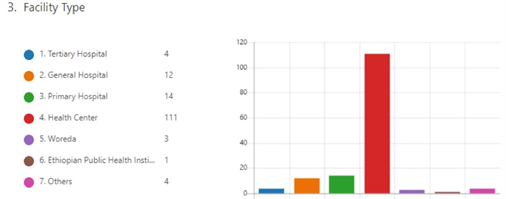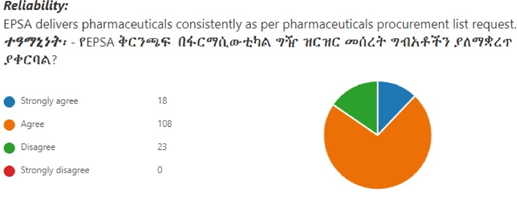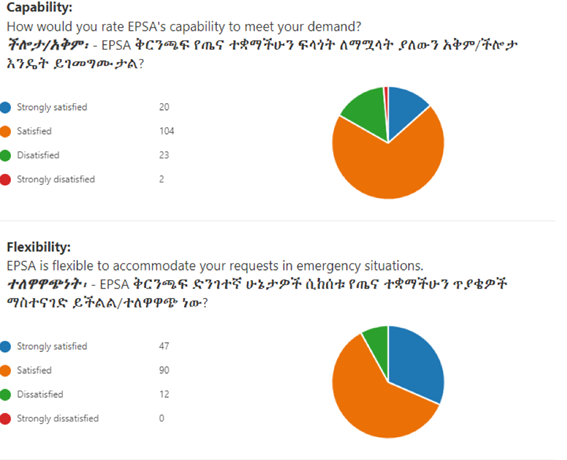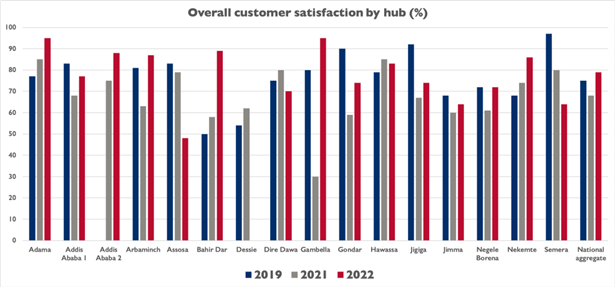In 2019, the EPSS, in collaboration with the USAID Global Health Supply Chain Program-Procurement and Supply Management (GHSC-PSM) project, established two tools to track customer satisfaction: an annual customer satisfaction survey and a web-based routine customer satisfaction monitoring system which is used to collect feedback when exiting after receiving services at EPSS branches.
The EPSS conducts the annual customer satisfaction survey among a randomly selected representative sample of 30-35 percent of the total health facilities (a minimum of 35 percent of hospitals, 30 percent of health centers, and 30 percent of woreda health offices; i.e., around 700 health facilities in total), proportionally allocated in all the hubs located across the country. Customers—pharmacy department heads or health facility managers—are interviewed to provide feedback regarding the services they get from the EPSS hubs. EPSS staff administer a paper-based structured survey questionnaire containing 23 Likert-type scale questions (answers should be provided on a 1-4 scale, where 1 indicates strongly dissatisfied and 4 strongly satisfied) to rate the EPSS based on key attributes of supply chain management such as reliability, responsiveness, capability, flexibility, and price. In the survey, customer satisfaction aligns with the attributes of the Supply Chain Operations Reference Model (SCOR, see Box I for additional resources), which comprise reliability, responsiveness, and adaptability. The survey also includes an open-ended question about the strengths and weaknesses of EPSS with respect to pharmaceutical supply management.
The survey questions fall into four thematic areas to understand the perception and experience of health facilities:
- supply chain performance
- customer relationship management
- EPSS contribution to build health facilities capacity
- overall satisfaction
In this way, the questionnaire provides health facilities’ reflections on key attributes of supply chain management, which help to triangulate health facilities satisfaction with quantitative findings from key performance indicators of the EPSS. For example, the health facilities experience on the reliability dimension “How would you rate EPSS consistent delivery of products per required quantity?” is triangulated with the key performance indicators line fill rate, order fill rate, and stockout rate to make informed decisions. The questionnaire is also designed to understand customer satisfaction for specific products—such as medicines, chemicals, or equipment—that could help target specific areas for improvement.
The EPSS uses SPSS statistical software version 25 to analyze the data collected in the annual survey and calculate descriptive statistics. The overall satisfaction is computed using the total sum of scores of satisfaction for each customer, calculated by adding responses to all survey questions. In this way, health facilities are classified as “satisfied” (or “not satisfied”) if the average health facility satisfaction is above (or below) a calculated threshold [threshold = (maximum score - minimum score) / 2].
In addition, EPSS and GHSC-PSM have developed a web-based customer satisfaction and feedback collection system (link in Box I) to obtain real-time feedback immediately after customers get service at the EPSS hubs. The system uses a self-administered online data collection system created with Microsoft Office Forms both in Amharic and English. All customers receive the URL for the customer satisfaction survey questionnaire that can be accessed through their phone or computer browser. The web-based system contains a total of 11 Likert-type scale questions to rate the EPSS accessibility, capability to avail pharmaceutical with fair price, reliability, responsiveness, and flexibility to meet customers’ demand. The system also has an online reporting dashboard showing a summary and visuals of the results for each of the 17 questions. Raw data from each hub are exported to SPSS software for further analysis, but national aggregated results are currently unavailable.




